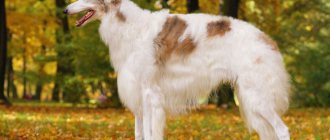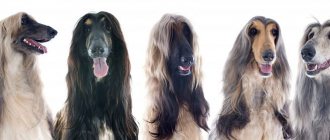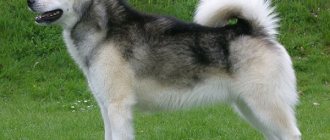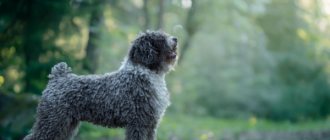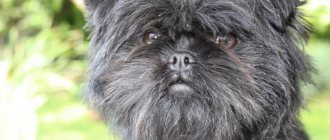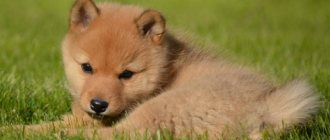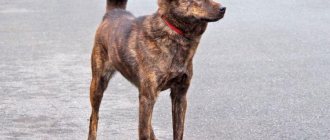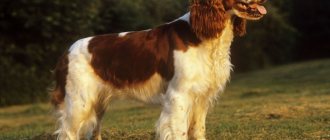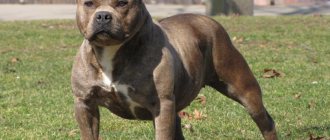Main characteristics
| Breed parameters | |
| Country of origin: | Russia |
| Weight of the breed: | males: 37-48 kg, females: 35-43 kg |
| Height at withers: | males: 85 cm, females: 78 cm |
| Temperament: | calm |
| Wool: | average |
| Role in human life: | companion, hunting |
The greyhound is an aristocratic dog. These animals love comfortable conditions, demand respect for their person and do not accept rude treatment, especially from the owner.
Origin story
The first mentions of amazing hunters date back to the 17th century. It is assumed that the first and very successful breeder of Russian dogs was Tsar A. M. Romanov, who received a pair of greyhounds as a gift from the Zaporozhye Cossacks. The graceful animals delighted the Russian Tsar so much that he could not stay away and began breeding.
There is also a version that the breed originated in Persia and on the territory of the Kazakh Khanate during the reign of Ivan the Terrible. How it was actually not known for certain.
Starting from the 18th century, dogs were subjected to total “pumping”. They were crossed with different types of hunting greyhounds without any specific goals. Selection occurred spontaneously, which led to fragmentation of the breed and inhibition of its development. Inept work greatly affected the external characteristics of the animals and their working qualities. The followers had to restore the gene pool for a long time and, bit by bit, collect what was valuable that remained. Therefore, the first standard was adopted only in 1888.
At the beginning of the 20th century, canine breeding accelerated and by the 17th year the quality livestock numbered about 2 thousand animals. However, the Second World War made its own adjustments to the breeding and popularization of the breed. During this period, many breeders were lost, and there was no one to take care of the dogs. After the end of hostilities, Russian enthusiasts started everything from scratch.
Russian dogs came to the United States at the beginning of the 20th century, after Europe became fed up with grace and hunting talents. It is worth noting that it was in America that Russian greyhounds gained the greatest popularity and demand. They are actively used as excellent hunters, sports sprinters and elite pets.
The purpose of the Russian greyhound
The main purpose of the breed instinct of the Russian greyhound is the pursuit of prey. Trophies in greyhound hunting are obtained without shots, exclusively by dogs.
.
This is possible thanks to the incredible speed that dogs can develop when running. The speed of the Russian greyhound in running is one of the main working qualities of the breed as a hunter. This breed can run at speeds of 50 to 60 kilometers per hour.
A dog's high speed depends on heredity and proper training. But still, the basis of speed qualities is genetically inherent agility. You can develop the qualities inherent in nature with the help of proper training. Full realization of potential also depends on proper feeding and injury prevention.
To develop running speed while walking, explosive and speed exercises are needed. Running after a thrown ball or stick helps develop the necessary qualities. Natural instinct helps train a dog to run after a person riding a horse or vehicle. Gradually increasing the speed of movement helps the dog learn to distribute forces when running.
Breed standard
The head is in the form of a narrow wedge, the muzzle is narrow and very long. Due to the large amount of curly hair on the body, the head appears very small in relation to the body. However, if you remove it, then it is quite proportional and harmonious.
The eyes are quite large for a small and narrow head, the gaze is penetrating and intelligent.
The nose is large, voluminous, black, regardless of color.
The ears are in the form of small triangles, hanging, tightly pressed to the skull. In general, they do not stand out particularly well and are more invisible than visible.
The body is long, flat, the back is curved, the chest is deep.
The belly is retracted, the tail is lowered down, slightly tucked at the end.
The paws are dry, sinewy, and high. In profile it seems that the dog is very impressive, in front it looks flat.
The wool is beautiful, silky, wrapped in soft rings, very soft to the touch. Acceptable colors :
- black and piebald;
- red-piebald;
- grey-piebald;
- tricolor;
- sexual;
- murugiy;
- grey;
- white.
Description of the breed
Greyhounds are one of the most elegant and graceful dog breeds in the world. Russian greyhounds are tall, but not heavy.
A male dog at the withers can reach from 75 to 86 cm, a female dog - 68 to 78 cm. Some are significantly higher, but the quality does not depend on height. The average weight of males is 40-45 kg, females 30-40 kg. They look thin, but not emaciated like an Azawakh, but muscular, although the body is covered with thick hair. The tail is long, thin, saber-shaped.
The head and muzzle of the Russian Borzoi is long and narrow, it is a dolichocephalic dog with a skull shape that is narrow at the base and long in length.
Since the head is smooth and narrow, it appears small relative to the body. The eyes are large, almond-shaped, with a smart expression. The nose is large and dark, and the ears are small.
The Greyhound has a long, silky coat that protects it from the Russian winter. It can be smooth, wavy or slightly curly, and hunters call it a hound.
Smooth and short hair on the head, ears and front of the paws. Many greyhounds have fur that is thickest and longest on the neck.
The coat color can be any, the most common: white, with large spots of red and fawn. Solid colored dogs were disliked in the past and are now rare.
Character and temperament
Russian dogs are true aristocrats, in addition, they are real geniuses of transformation. In nature, while working, they are frantic and tireless, at home they are melancholic and indifferent, they are almost inaudible. They are considered the most comfortable pets and comfortable family pets. Greyhounds are not particularly talkative, unobtrusive, do not suffer from loneliness, and prefer to sleep quietly on the sofa or at the feet of the owner. The breed is simply incapable of all kinds of dirty tricks, of course, provided that the animal is regularly walked.
These dogs are indifferent to children; they do not excite them, but they also do not cause aggression. The only thing your pet may not like is sounds that are too loud and harsh, as well as causing pain.
Pros and cons of the Russian Greyhound breed
There are both advantages and disadvantages in keeping a Russian greyhound. Let's consider both.
Pros:
- Speed. This dog can reach speeds of up to 100 km/h over short distances. On average, she can run 60 km/h for a long time and catch up with most animals.
- Phlegm. Most Russian Greyhounds can lie still for a long time and do nothing. They do not attract attention to themselves, which is very pleasing to the owners, who may be busy people.
- Excellent physical shape. The dog does not know clumsiness, it is distinguished by aristocracy and grace.
Minuses:
- Requires a lot of space. As mentioned above, the Russian Greyhound can live in an apartment. But provided that it is not a one-room apartment.
- Frequency of walks. The dog needs a lot and often walks. Therefore, if you do not have a lot of time, then it is best not to get a Russian greyhound.
Education and training
Despite all the apparent obedience and readiness to follow any commands, dogs are not the best students and are far from excellent students. They should not be subjected to basic training. Modern dog handlers recommend focusing on their natural talents, that is, hunting.
With a Russian Greyhound, you always need to keep your finger on the pulse, because she can perceive even the slightest change in her voice as a personal insult and become truly offended. So during classes you need to control yourself and control all your actions.
The first thing the owner should formulate with his pet is a clear distinction between hunting and ordinary life. A dog should not behave at home the same way as when hunting. Gradually teach the puppy to behave correctly on the street; you should not let him run after cats or react sharply to small dogs. Never let your four-legged friend off the leash if there are many small animals nearby.
The best way to combat teenage leadership is with additional loads. Ideally, during the period of growing up, there will be an adult nearby who will show and explain how to behave.
general characteristics
The Russian Greyhound is a calm and sensitive dog, an excellent assistant in field hunting. This obedient giant responds to his owner's love with boundless gratitude. Discreet and noble, this dog is not designed for rough handling or aggressive training.
She would be more suited to basic obedience training. Behaving impeccably, she expects to receive respect in return, including from children. Despite its love for running and frequent walks, the Russian Greyhound will happily relax in a cozy place in the house or yard.
For example, she won’t mind lying on her owner’s bed, and such a choice should not be encouraged. The greyhound's relationship with its owner is truly similar to religion. She idolizes her owner and is infinitely devoted to him.
But everything else - the house, children, other family members and pets - is considered only as an “appendage” of the beloved “leader”. Therefore, when choosing a greyhound, be prepared that your pet will ignore everyone outside of its home and family.
Maintenance and care
The undemanding nature of canines makes it possible to keep them in an apartment, however, subject to constant physical activity. These animals must often and for a long time walk, run and frolic. In the house, dogs should have their own corner, a cozy sleeping place and bowls for food and water on a special stand.
True aristocrats at heart, Russian dogs extremely dislike ordinary loungers and will not stoop to the level of ordinary dogs. They vitally need their own sofa or small bed as a bed. If you don’t give in to them on this little detail, be prepared for the pet to settle down with you.
If a dog lives in an enclosure, then it should have a comfortable kennel with an instructed bed, and not a simple lounger. They are fastidious about hygiene. Their coat, although devoid of undercoat, is still prone to matting. They will have to be brushed frequently and the fur detangled after walks. Otherwise, greyhounds are very clean and take excellent care of themselves. During the molting period they require more attention.
How to choose a Russian greyhound puppy
If you are not going to hunt, then the greyhound can very well act as a dog that guards the house. Even if this is so, you still need to learn from experienced dog breeders who breed the breed all the details of the right choice.
Sometimes it happens that in your city there simply isn’t the right person. The only thing that can be advised in such a situation is to be patient and wait. This may take weeks or even months.
The ideal solution is to adopt a puppy that is already 10 months old . At this age he had already received all the necessary vaccinations. Also, the puppy will be able to fully perceive and carry out all the commands that the new owner gives him.
It is worth paying attention to what gender the Russian greyhound puppy is. Males are less phlegmatic than females. This means they are more excitable.
Nutrition
You will have to feed your Russian dog often, at least 3 times a day, and preferably 4. Portions should be small. If the basis of the diet is industrial feed, then it should only be of high quality. If the food is natural, then more than 70% should be raw, lean meat. Many breeders recommend horse meat; you also need to add sea fish, a small amount of cereals (buckwheat, oatmeal, rice), vegetables and some types of fruits.
For proper growth and maintaining an ideal balance, the animal’s food must be rich in proteins, calcium, vitamins and essential microelements. During the period of teeth change, it is advisable to add mineral supplements and an egg to the diet.
Foods that should not be given:
- Vegetables with high starch content.
- Bony, river fish.
- Fatty meats.
- Sweets, chocolate.
- Tubular bones.
- The owner's food.
- Beans.
You should feed after a walk. The portion should be sufficient so that the dog does not chase the empty bowl, licking it.
Hunting with Russian greyhounds
The original purpose of the Russian Greyhound breed is hunting. To use a dog for its intended purpose, special training is required. First of all, physical training of the puppy is necessary. He must constantly run and play in order to develop dexterity, agility, and dexterity in his grip.
The greatest effect can be achieved if the games are accompanied by a companion of a different breed - the element of competition will make the training more effective.
The puppy is taught to use a whistle and a horn, the sounds of which will indicate the commands “sit”, “lie down”, “come to me”. Jumping behind a horse or bicycle is carried out with a tied carcass of a hare or fox. This technique teaches the dog to pursue prey, distributing its own forces while running.
Next, the Russian greyhound is matched with a hare or fox. Wolf training is carried out when the dog is at least 12 months old. If the greyhound does not have good physical qualities, it is better not to take risks. Baiting a wolf is a difficult task, so it is not recommended for a hunter to carry it out alone. Young greyhounds are baited accompanied by adult dogs.
IMPORTANT. A dog is taken on a hunt only after it has completed a full course of training and follows all commands.
Hunters go hunting with Russian greyhounds in groups of three or four people. The dogs are sent out in packs to search all the animal's roosting areas. In the pack there is a leading dog that catches up with the animal and slows down its movement; the partners arrive in time and take the animal.
